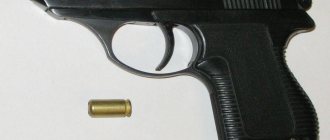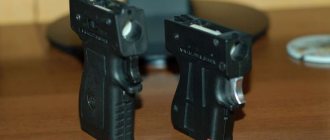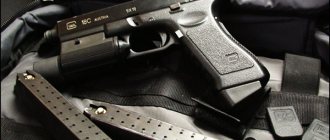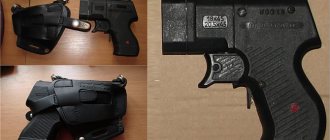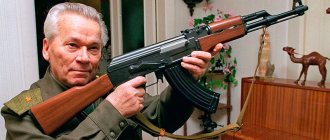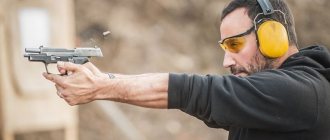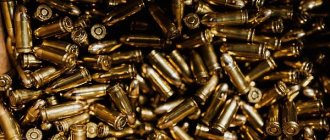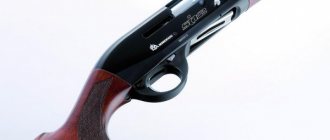Calibers of traumatic weapons
Traumatic weapons include pistols and revolvers that fire rubber bullet cartridges. Each injury has its own caliber, which is indicated in the product passport and on the case. Cartridges for traumatic weapons consist of a casing (bimetallic, aluminum, steel or brass), a powder charge and a rubber bullet. The projectile inserted into the magazine or drum must match the caliber of the specific pistol or revolver.
Types of calibers of traumatic weapons:
- large-caliber (18.5x55, 18x45);
- medium-caliber (10x22T, 10x28, 10x32, .44TK, 45 Rubber, 13x45, .45x30);
- small-caliber (.380 IU, 9 RA).
.380 IU
.380 ME GUM is used in traumatic revolvers T-96M, “Shershen-1”, “Gadfly”, Reck mod.60, “Agent TKB-0216 T-01”. Shells of this caliber are produced by Novosibirsk Refinery Plant, Novgorod AKBS, Pobjeda (from Bosnia and Herzegovina). Traumatic ammunition version .380 ME is created on the basis of a revolver cartridge. Near the bottom of the cartridge case there is a protrusion that serves for convenient fixation in the revolver cylinder. The .380 ME round is not suitable for a pistol.
Characteristics of .380 ME:
- power 25-30-40-50 J;
- for sports shooting;
- 240-350 m/s;
- weight 4.8-5.22 g;
- sleeve / 22-23.5 mm length;
- rubber ball / 10 mm / 0.7-0.8 g.
9 R.A.
This is a cartridge for traumatic pistols (“Groza-01M”, “Strela”, “Smerch”, “Vostok-1”, M-P17T, P-M20T, MR-78-9TM, MR-79-9TM, P-M21T) . The 9 RA caliber projectile is produced by: “TEMP”, “TEKHKRIM”, Tula “TPZ”, Klimovsky “KSPZ”, “NPZ”, “AKBS”.
Characteristics of 9 RA:
- 50-91 J;
- penetration force depends on the design of the barrel;
- 250-430 m/s;
- sleeve / 22-22.2 mm / 4.1-4.2 g;
- rubber ball / 9.3-10 mm / 0.55-0.60-1.00-1.13 g;
- 16-20-50 pieces per package.
10x22 T
10x22T is used in traumatic pistols (Grand Power T10, STREAMER-T, APS-M, Phantom-T). Popular, “Fortune”, “AKBS”.
Characteristics of 10x22T:
- 50-84 J;
- weak power;
- 250-350 m/s;
- 5 grams / 22.7-23.5 mm;
- sleeve / 22 mm;
- rubber bullet / 10 mm / 0.70-1.00-1.13 g;
- 20-25 pieces.
10x28
10x28 is used in the following weapon models: Grand Power T12, “Shadow-28”, R226T TK-PRO, TT-T.
, “Fortune”, CHASE, “TEMP”, “AKBS”.
Characteristics 10x28:
- 80-91 J;
- high penetration power and stopping effect;
- 300-401 m/s;
- sleeve / 28 mm;
- bullet / 11.5-12 mm / 1.28-1.35-1.44-1.80-2.00 grams;
- 20-25-50 pieces.
10x32
10x32 are used in traumatic pistols: TTK-DF, Leader, VPO-501, TT-Leader. The best companies are Fortuna, Barnaul BPZ.
Features 10x32:
- 50-60 J;
- weak power;
- 250-355 m/s;
- weight 6.5-7.8 grams;
- sleeve / 32.5-33 mm length;
- rubber bullet (one TM ball or two T balls) / 0.65-0.75 g / 10 mm;
- 20-25 pieces.
.44 TK
.44TK is loaded with TK1911T brand traumatizers. A popular ammunition manufacturer is Izhevsk.
Features of .44TK:
- 80-91 J;
- characterized by optimal accuracy;
- 351 m/s;
- rubber ball / 1.00-1.30-1.50 g / 11.5-13.0 mm;
- pack of 20 pieces.
.45 Rubber
.45 Rubber is used in trauma weapons: MP-80-13T, Strela M-45, MP-353. They produce ammunition such as "BPZ", "Fortuna", "Kalashnikov", "AKBS".
Features of .45 Rubber:
- 70-90 J;
- stopping effect;
- 250-325 m/s;
- cartridge / 23.5 mm / 7.7 g;
- rubber ball / 13 mm / 1.5-1.8 g;
- 12-20-50 pcs. packaged.
.45x30
.45x30 are used in the Grand Power T15-F pistol. Such ammunition is manufactured in Russia.
Description .45x30:
- 80-91 J;
- 210 m/s;
- stopping effect;
- 30 mm sleeve;
- rubber ball 15 mm;
- weight of thrown equipment 4 g;
- 12 pcs. in a pack.
18x45
18x45 caliber shells are used in the Osa, Aegis, PB-4, MR-461 Guardian, and Shaman trauma weapons. Ammunition is manufactured by Glyf-Inzhpribor and Sergiev Posad.
Characteristics 18x45:
- 80-85-91 J;
- 125-160 m/s;
- powerful projectile, but does not pass through thick clothing;
- weight 25 grams;
- sleeve / 45 mm length;
- bullet / 15-15.3 mm / 6.0-11.6-12.0 grams;
- 4 things. in a pack.
18.5x55
18.5x55 are used in the Osa-PB-4-2 55T and OSA M-09 LCU versions. Sergiev Posad also produces this ammunition.
Features 18.5x55:
- up to 91 J;
- 115 m/s;
- powerful but slow bullet;
- cartridge weight 29 grams;
- rubber ball / 11.6-14.0 g;
- 4 things. in a pack.
Advantages and disadvantages of APS-M
Pros and cons
The robust design of the “donor” - the APS combat pistol - is preserved at the level of the mechanisms and frame of the pistol. The barrel can be considered reliable only after heat treatment;
Lightweight compared to the combat model, the pistol demonstrates greater comfort when shooting;
Significant magazine capacity, even with the limiter installed;
Excluding changes to the barrel, the pistol looks the same as its combat brother, and in some cases it helps out with its appearance alone;
Good shooting accuracy for a traumatic weapon.
The need for “finishing with a file” - the pistol must be modified after purchase, namely, the barrel must be polished inside, heat treated, otherwise the spike in the barrel bore can damage the rubber balls, as well as inflate the chamber when fired;
The dimensions of the pistol do not allow it to be carried concealed, and not every shooter will be comfortable holding the pistol due to anatomical capabilities (hand size);
Transferred from a combat pistol, and the heavy trigger when shooting with self-cocking has not been eliminated, as well as the long travel of the trigger;
The front sight retained its dimensions when the weapon was converted to traumatic, but the rear sight was slightly expanded - this creates difficulties during aimed shooting;
Due to the installation of the internal sleeve, the barrel has received a strong narrowing, which significantly reduces the speed of the bullet, and thereby reducing the traumatic effect on the aggressor;
A relatively weak cartridge APS M 10x22t whose muzzle energy is insufficient to seriously influence the aggressor at a distance of over two meters. Beyond that, its muzzle energy of 50 Joules is not enough to create a reliable stopping effect.
Although in general, despite its shortcomings, the Stechkin traumatic pistol performs its tasks well, but only under certain conditions. Yes, it has a reliable mechanism, it is difficult to break, but it cannot be used with more powerful cartridges, and since 2011 the pistol is practically not available for free sale in stores - this is caused by the stop in the production of this weapon. The options that exist are mostly in the hands of private collectors or simply owners of self-defense weapons, and these items are rarely sold.
Which caliber is better?
Traumatic cartridges are used in pistols and revolvers of the LLC brand. According to the law, the power of such projectiles should not exceed 91 J. Small-caliber weapons are loaded with light cartridges with relatively little penetrating force. However, even a small bullet during a test test penetrates ballistic gel (a substitute for human soft tissue) by 20-40 mm.
Large-caliber weapons are loaded with powerful cartridges. Penetrating force depends on the mass of the rubber ball and the amount of powder charge. Of course, large-caliber pistols shoot stronger than small-caliber pistols.
Features of traumatic projectiles of different calibers:
- a powerful but heavy bullet will not pass through winter clothing;
- a light ball has a weak stopping effect, but strong penetration ability;
- the higher the speed at which the bullet leaves the barrel, the stronger the penetrating force;
- a steel casing can withstand a larger load of gunpowder than a brass or bimetallic casing;
- weak bullets weighing no more than 0.5 g and a power of 30 J are not recommended for self-defense.
The most popular shells are 10x28 (good penetration), 9 RA (high speed), 18x45 (strong stopping effect). The power of the cartridge reduces the distance and the presence of outer clothing of the attacker. If it gets into the eye, temple, or neck, it can be fatal.
Grand Power T10 gas pistol caliber 10x22T, Slovakia
Ammo
Use only standard factory-made cartridges of the appropriate 10x22T caliber. Stable operation of the pistol is guaranteed only with PP10x22RP (50 J) cartridges TU 7272-023-25544379-2007 produced by PKP AKBS LLC.
Change of store
Hold the pistol in your right or left hand, press the magazine release with your thumb and remove the magazine with your other hand (Fig. 1)
Shop equipment
Grip the magazine in one hand, holding it with the open neck facing up. Place the cartridge over the magazine feeder. Push the cartridge down and back until it touches the rear, flat wall of the magazine. Place the next cartridge on top of the previous cartridge and press down and back. When several cartridges are already loaded into the magazine, press them lightly with the thumb of the hand that holds the magazine.
Do not attempt to exceed the magazine capacity as this may cause feeding failures.
Loading a pistol
Warning: Make sure the gun is pointed in a safe direction first!
Insert the loaded magazine and make sure it is locked into place by the magazine latch. Remove the pistol from the safety (fire position). Hold the pistol by the grip with one hand and use the thumb and forefinger of the other hand to grasp the serrated ridges on both sides of the slide. Pull the bolt all the way back and then allow it to return forward by removing your hand.
This procedure cocks the hammer and forces a cartridge into the chamber. The gun is now ready to fire. If you are not going to open fire immediately, follow the safety rules in the future.
Shooting
Press the trigger, after firing the gun will automatically eject the cartridge case and send a new cartridge from the magazine into the chamber.
Reloading while shooting
When the last cartridge is expended, the bolt will remain in the rear position on the bolt stop. Replace the empty magazine with a loaded one. Press the thumb of your shooting hand or free hand onto the slide stop and allow the slide to return forward. The pistol is again loaded and ready to fire (Fig. 2).
Unloading a pistol
Warning: Make sure the gun is pointed in a safe direction first!
- take out the magazine
pull the bolt back and make sure that the last cartridge has been extracted from the chamber and has been ejected
Safe mode
Squeeze the handle of the loaded pistol, POINTING IT TO A SAFE PLACE. With the thumb and forefinger of your other hand, grip the trigger firmly, pull the trigger, and lower the trigger slowly and gradually until it “lands” in place.
Release the trigger.
Use extreme caution when releasing the trigger to avoid accidental discharge! It is recommended to practice this operation on an unloaded pistol. The design of this weapon includes such a feature that the manual safety cannot be engaged when the hammer is not cocked, this is done to increase the readiness of the pistol for combat use.
Adjusting the line of sight
The pistol was zeroed at the factory at a distance of 10m, so the average point of impact corresponds to the aiming point.
Care and preservation instructions
Disassembling the pistol.
Warning: Point your gun in a safe direction!
- Take out the magazine. The pistol should not be disassembled with the magazine inserted!
- MAKE SURE THERE IS NO CARTRIDGE IN THE CHAMBER!
- Hold the pistol by the grip with one hand, wrap the index finger of your other hand around the trigger guard, and place your thumb on the underside of the front of the slide and pull straight out and down until the trigger folds down completely (Fig. 3)
- Move the bolt back all the way, lifting the rear part, move the bolt forward until it separates from the barrel and frame (Fig. 4).
- Remove the spring and spring guide. No further disassembly is required for routine maintenance. When a large number of cartridges have been shot, we recommend cleaning the firing pin and magazine, which is best done by an experienced gunsmith in a workshop.
Cleaning the gun
Clean the gun:
- as soon as possible after the shooting
- if you wet the gun
- at least once a year in moderate climates
- at least once a month in tropical climates or other conditions requiring it
After firing gas cartridges, use alcohol-containing solutions to remove any remaining active substance when cleaning. Remember that cleaning with alcohol-containing solutions does not neutralize the active substance, but only allows its residues to be transferred to the cleaning material.
Cleaning the chamber and barrel
If the pistol has not been fired or few shots have been fired, clean the barrel and chamber with a clean soft rag on a cleaning rod. When the barrel is very dirty, use solvent and a brush. Allow the composition to work for approximately 10 minutes (this time varies depending on the composition used). Then wipe down the entire barrel.
Then run a clean rag through the barrel and check to see if all the carbon has been removed. Repeat this procedure until you achieve this.
The cleaning rod and brush must be inserted into the barrel from the chamber side to avoid damage to the bore and chamber. Push the brush the full length of the barrel before moving back. If you try to change the direction of movement of the brush in the barrel, the brush may get stuck.
Cleaning the gun's greasy parts
It is enough to wipe the remaining parts of the pistol (including the outer surface of the barrel) with a cleaning material slightly moistened in gun oil.
Preservation and re-preservation
When the barrel, chamber and all accessible parts are clean and dry, wipe them with a cloth soaked in gun oil or use a spray.
Use thick preservative grease only for long-term preservation in aggressive environments. Before any use of the pistol, it must be completely removed from all parts of the weapon.
Always wipe the barrel and chamber dry before shooting! Remove all excess oil from all accessible parts. At very low temperatures, use a lubricant formulated specifically for these conditions.
Troubleshooting
| Malfunction | Possible reason | What to do |
| The cartridge did not enter the chamber or the bolt did not lock the barrel | Magazine not fully inserted or damaged | Insert the magazine correctly or replace the magazine |
| Gun or cartridges are dirty or overly lubricated | Clean the gun with cartridges and wipe them dry, or alternatively they may be slightly greased | |
| Misfire | Malfunctioning magazine | Press the shutter again. If the shot does not occur, follow the safety precautions for delayed shooting. |
| The firing pin is dirty or not properly lubricated for the conditions. | Clean the firing pin and firing pin bore, use low temperature lubricant | |
| The shot sounds quiet and the cartridge is not ejected | The capsule fired, but there was no gunpowder in the cartridge | Make sure that the bullet is not stuck in the barrel, otherwise a subsequent shot may cause damage to the plastic or trigger guard. There is not enough gunpowder in the cartridge. |
| The cartridge is not extracted | The chamber, extractor or ammunition is dirty or the lubricant is incorrectly selected for low ambient temperatures | Clean and dry the gun. Use new and clean ammunition. |
If your gun is used and maintained correctly, failures will occur very rarely. However, if such a situation occurs, please follow the recommendations.
Warning: If there is a delay, the likelihood of an accidental discharge increases significantly. Therefore, please read the safety rules mentioned above carefully. Keep the gun pointed in a safe direction and do not turn the gun towards yourself or anyone else. Do not place your hands in front of the barrel.
If you cannot fix the malfunction using the methods described above, entrust the pistol to an experienced gunsmith for inspection and repair.
Parts List
- - shutter
- - barrel with insert
- - return spring
- - trigger guard
- - trigger
- - frame
- - front sight
- - rear sight
- - fuse
- - shutter stop
- - trigger
- - store button
- - shop
- — bar
The Manufacturer and/or its Official Representatives do not accept responsibility for malfunction of the product, personal injury or damage to property resulting from criminal or negligent use of this product, improper or careless wearing or storage, prohibited design changes and the use of damaged, unsuitable, reloaded or recycled ammunition , user abuse, or careless care of this product, or other causes beyond the direct and immediate control of the Manufacturer.
The manufacturer is constantly working to improve the pistol, so some design changes may not be reflected in this passport.

